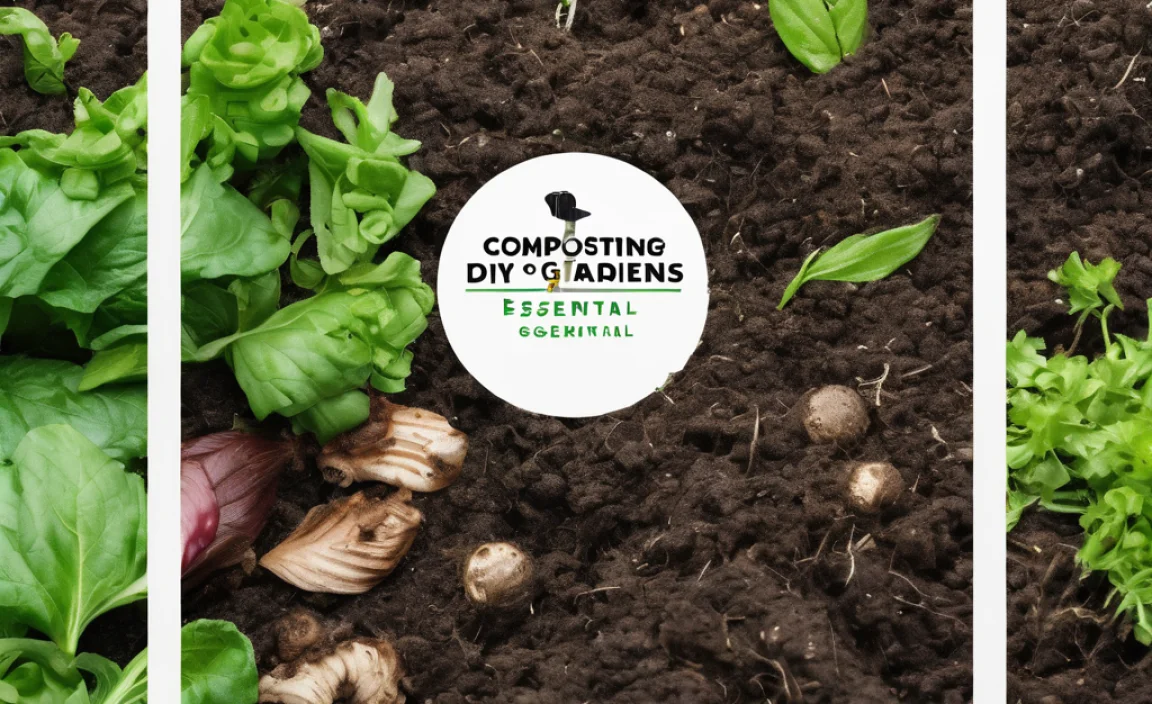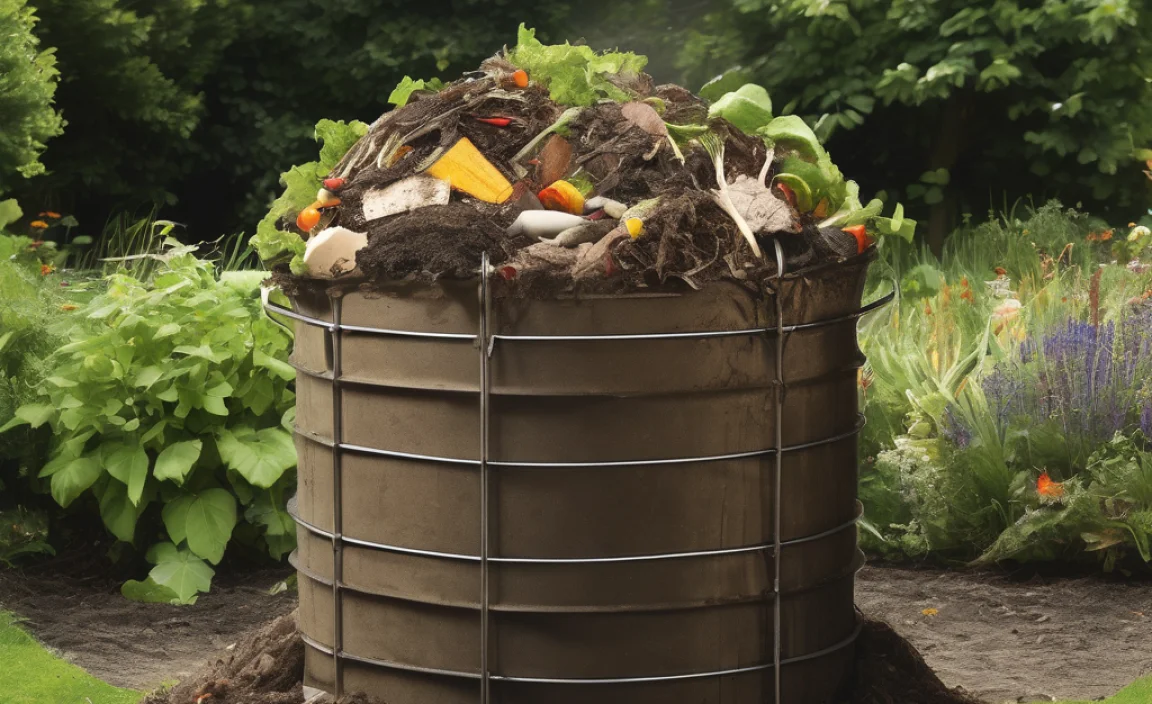Ever looked at your compost bin and wondered what magic is happening inside? It’s all thanks to tiny, invisible helpers: compost microbes! They’re the real MVPs of your compost pile, turning kitchen scraps and yard waste into nutrient-rich food for your garden. But what exactly are these microbes, and how can we give them a super-boost? We’re going to dive into the fascinating world of compost microbes and explore some awesome ideas to make your composting even better. Get ready to transform your waste into garden gold!
The Unseen Army: What Are Compost Microbes?
Think of compost microbes as a miniature ecosystem working tirelessly in your bin. These aren’t just a few guys; they are trillions of bacteria, fungi, and other microorganisms. They’re so small you can’t see them without a powerful microscope, but their impact on breaking down organic matter is enormous. Without them, your banana peels and grass clippings would just sit there forever!
The process of composting relies on these tiny organisms consuming the materials you add. As they eat, they reproduce and release energy in the form of heat. This heat is crucial for speeding up decomposition and killing off weed seeds and pathogens. Different types of microbes work at different stages and temperatures, creating a dynamic biological process.
Bacteria: The Fast Workers
Bacteria are the most abundant microbes in a compost pile. They are the workhorses that get everything started, especially in the early, hotter stages of composting. These little champs thrive in warm, moist conditions.
- Mesophilic Bacteria: These are the initial decomposers. They work best in moderate temperatures (around 50-100°F or 10-38°C). They start by breaking down sugars and starches from fresh organic materials.
- Thermophilic Bacteria: As the compost pile heats up, mesophilic bacteria create an environment where thermophilic bacteria can take over. These guys love the heat (130-160°F or 55-70°C) and are responsible for rapid decomposition. This high-temperature phase is vital for killing harmful pathogens and weed seeds.
Fungi: The Tough Material Breakers
While bacteria excel at breaking down simple compounds, fungi are the experts at tackling tougher materials like wood chips, lignin, and cellulose – things that might take longer to break down otherwise. They often appear as white, thread-like structures called hyphae.
- Fungi have powerful enzymes that can break down complex carbon compounds.
- They are particularly important in the cooler, later stages of composting when temperatures drop.
- They contribute to the earthy smell and crumbly texture of finished compost.
Actinomycetes: The Filamentous Friends
Actinomycetes are a fascinating group of microbes that share characteristics of both bacteria and fungi. They look like long, branching filaments, similar to mold. They are responsible for that classic, earthy smell of healthy soil and a well-aged compost pile.
- They are especially good at decomposing more resistant materials like proteins, cellulose, and chitin.
- They play a key role in the later stages of composting, helping to create a stable, mature compost.
- Their presence is a good indicator of a healthy, biologically active compost.
Protozoa and Nematodes: The Micro-Predators
While bacteria and fungi are busy eating, they also become food for other organisms. Protozoa and nematodes are microscopic animals that feed on bacteria and fungi. This predation helps to regulate microbial populations and release valuable nutrients back into the compost.
These larger organisms are important for nutrient cycling, making essential elements like nitrogen more available for plants. They are more common in mature compost and indicate a well-balanced, healthy ecosystem.
Why Boost Your Compost Microbes?
Composting is a natural process facilitated by microbes, but we can often give them a hand to make the process faster, more efficient, and produce higher-quality compost. Boosting your microbial activity can lead to:
- Faster Decomposition: A thriving microbial population breaks down organic matter more quickly, meaning you’ll have finished compost sooner.
- Reduced Odors: When microbes break down materials aerobically (with oxygen), they produce less of the unpleasant gases associated with anaerobic decomposition (without oxygen). A healthy, active pile smells earthy.
- Better Compost Quality: Microbes are essential for creating nutrient-rich, well-structured compost that can dramatically improve your garden soil.
- Disease Suppression: A robust microbial community can outcompete or even attack plant pathogens, leading to healthier plants. You can learn more about soil health and beneficial microbes from university extension resources, such as those found on University of New Hampshire Extension.
Compost Microbes Ideas: Essential Breakthroughs
So, how do we create the ultimate spa for our compost microbes? It’s about providing the right conditions and sometimes a little helpful addition. Here are some practical and groundbreaking ideas to supercharge your compost pile.
1. The Perfect Recipe: Balancing Greens and Browns
Microbes need a balanced diet, just like we do! In composting, this balance is between “greens” (nitrogen-rich materials) and “browns” (carbon-rich materials). Think of it as their primary energy source (greens) and their structural building blocks (browns).
A good ratio is generally around 25-30 parts carbon to 1 part nitrogen by weight. This translates to roughly 2-3 parts browns to 1 part greens by volume for kitchen and yard waste. Too much green can lead to a slimy, smelly pile, while too much brown can slow decomposition.
Common Greens (Nitrogen-rich):
- Fruit and vegetable scraps
- Coffee grounds and tea bags
- Grass clippings (in thin layers)
- Fresh plant trimmings
- Manure (from herbivores like cows, horses, chickens)
Common Browns (Carbon-rich):
- Dry leaves
- Shredded newspaper and cardboard (non-glossy)
- Straw and hay
- Wood chips and sawdust (in moderation)
- Twigs and small branches
Pro Tip: Chop larger materials into smaller pieces. This increases the surface area, giving microbes more to munch on and speeding up the process.
2. Moisture: The Lifeblood of Microbes
Compost microbes need water to survive and function. Too dry, and they go dormant. Too wet, and you risk creating an anaerobic environment that fosters foul odors and slows decomposition.
The ideal moisture content is like a wrung-out sponge – damp but not dripping. When you squeeze a handful of compost, only a drop or two of water should come out. You can check this by grabbing a bit of material from the center of your pile. If it feels dry, add water while turning.
How to manage moisture:
- Too Dry: Sprinkle water over the pile as you add new materials or turn it.
- Too Wet: Add more dry brown materials (like shredded newspaper or leaves) and turn the pile to improve aeration. Ensure your bin has good drainage.
3. Aeration: Giving Microbes Room to Breathe
Most of the beneficial compost microbes are aerobic, meaning they need oxygen to survive and do their work. Without enough air, the pile can become compacted, leading to anaerobic conditions, which are slow and smelly.
Methods for aeration:
- Turning the Pile: This is the most effective way to introduce oxygen. Aim to turn your compost pile every 1-2 weeks, especially during the active heating phase. Use a pitchfork or a compost aerator tool.
- Layering Materials: Interspersing layers of bulky brown materials (like twigs or wood chips) throughout your pile helps create air pockets.
- Using Aerated Bins: Some compost bins are designed with vents or systems to improve airflow.
A well-aerated pile will heat up more effectively and decompose faster.
4. Temperature: The Warm Fuzzy Feeling
As mentioned, different microbes thrive at different temperatures. A hot compost pile (130-160°F or 55-70°C) is a compost microbe party zone! This high heat is crucial for killing weed seeds and pathogens. It’s primarily driven by thermophilic bacteria.
To achieve and maintain high temperatures, you need a good carbon-to-nitrogen ratio, adequate moisture, and sufficient aeration. A pile that is too small won’t retain heat, so aim for a minimum size of about 3x3x3 feet (1 cubic yard).
Monitoring Temperature:
You can use a compost thermometer to track the temperature. Burying it in the center of the pile is the best way to get an accurate reading. After reaching high temperatures, the pile will cool down, allowing mesophilic microbes and fungi to take over for the curing phase.
5. Introducing Beneficial Microbe Boosters
Sometimes, you might need to give your compost a little jump-start, especially if your starting materials are slow to break down or if your pile seems sluggish. Here are some ideas:
- Finished Compost or Healthy Soil: A shovel full of mature compost or good garden soil acts as a starter. It inoculates your new pile with a diverse community of active microbes. Sprinkle it in as you build your layers.
- Yogurt or Buttermilk (with live cultures): The probiotics in these dairy products are beneficial bacteria. A cup or two drizzled into the pile can introduce more microbial diversity. Make sure it’s plain yogurt or buttermilk with active cultures – not pasteurized or flavored.
- Worm Castings: While not directly adding microbes in large quantities, worm castings are teeming with beneficial bacteria and fungi, plus they add valuable nutrients and improve soil structure.
- Commercial Compost Accelerators: These products are often a blend of dormant microbial spores and nutrients designed to kick-start decomposition. Follow the product instructions carefully. Some are simply a blend of dried microbial cultures that reactivate when added to a moist compost pile.
6. Shredding and Size Reduction
This is a simple yet incredibly effective “breakthrough” for accelerating microbial action. Microbes work on the surface of materials. The smaller the pieces, the more surface area is exposed, and the faster they can get to work.
Why it matters:
- Larger items like whole potato peels or large branches will take much longer to break down.
- Shredding leaves, chopping up kitchen scraps, and running over grass clippings with a mower a few times creates tiny particles that microbes can quickly consume.
- This is especially important for carbon-rich materials like wood chips or straw.
7. The Importance of pH
Microbes are sensitive to pH levels. Most composting microbes prefer a slightly acidic to neutral pH, typically between 6.0 and 8.0. Extreme pH levels can inhibit microbial activity.
How pH levels can be affected:
- Adding too many acidic materials (like pine needles or citrus peels) can lower the pH.
- Adding alkaline materials (like wood ash) can raise the pH.
Maintaining optimal pH:
- Balance your Greens and Browns: This usually helps keep pH in check naturally.
- Avoid excess of single materials: Don’t overload the pile with materials known to be very acidic or alkaline.
- Test your Compost: You can use a simple soil pH test kit to check your compost’s pH. If it’s too acidic, you can add a small amount of lime or wood ash. If it’s too alkaline, add some drier, acidic materials like peat moss or pine needles.
Remember, finished compost usually has a neutral pH, which is great for most garden plants. You can find more information on soil pH testing and amendment strategies from reputable agricultural sources like the USDA Natural Resources Conservation Service.
8. Creating a Compost Tea Garden (Brewing for Your Bin)
Compost tea is essentially a liquid extract of beneficial microbes and soluble nutrients from finished compost. You can use it to “inoculate” a new or sluggish compost pile, giving it a concentrated dose of active microbial life.
How to make a basic compost tea:
- Fill a bucket with non-chlorinated water (let tap water sit out for 24 hours to dissipate chlorine).
- Add a shovelful of finished compost or worm castings.
- Optional: Add a small amount of food-grade molasses as a food source for the microbes.
- Aerate the mixture using an aquarium pump and airstone for 24-48 hours. This keeps the microbes alive and multiplying.
- Strain out the solids.
- Pour the liquid over your compost pile, or use it to water your garden.
This method is great for giving your compost pile an immediate boost of microbial power.
9. Consider Advanced Composting Methods
While we’re focusing on beginner-friendly ideas, it’s worth knowing that more advanced methods leverage microbial understanding for even faster and more controlled composting:
- Vermicomposting (Worm Composting): Uses earthworms to break down organic matter, producing nutrient-rich “worm castings.” This is great for smaller spaces and produces high-quality compost quickly.
- Bokashi Composting: An anaerobic fermentation process that uses a special bran inoculated with effective microorganisms (EM). It pickles food waste and can handle meat and dairy, but requires adding it to a traditional compost pile or burying it to finish.
- Hot Composting: Actively managing a compost pile to reach and maintain high temperatures (over 130°F or 55°C) for several weeks. This requires careful attention to C:N ratio, moisture, and aeration but results in very fast composting and pathogen elimination. Resources from university programs, like University of Kentucky Extension, can provide more details on these advanced techniques.
These methods all rely on understanding and managing microbial activity but offer different benefits and levels of effort.
Troubleshooting Your Microbial World
Sometimes, despite our best efforts, a compost pile can be a bit stubborn. Here’s how to diagnose and fix common microbial-related issues.




